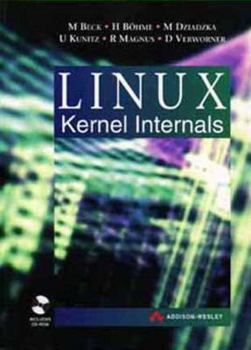Linux Kernal Internals, with CD-ROM
Select Format
Select Condition 
Book Overview
Brand-new edition of the comprehensive Linux kernel reference - 40% of material revised. Now updated throughout to cover Linux 2.4. This description may be from another edition of this product.
Format:Paperback
Language:English
ISBN:0201877414
ISBN13:9780201877410
Release Date:July 1996
Publisher:Addison-Wesley Professional
Length:480 Pages
Weight:1.25 lbs.
Dimensions:0.9" x 6.7" x 9.2"
Customer Reviews
5 ratings
Great intro to Linux internals
Published by Thriftbooks.com User , 20 years ago
I found the explanations in this book to be very clear, giving enough detail for a good head start into Linux internals. The book briefly explains the OS concepts, such as semaphores, virtual memory, etc., followed by an overview of how each is implemented in Linux, and code snippets. Most of the code snippets are simplified for readability, which I found useful because the hacks can be distracting (scary, too) for a beginner. Detailed and up-to-date information can best be obtained from source code itself.The book assumes some familiarity with Unix concepts, as it mentions such buzzwords as POSIX, BSD, and SVR4 in the context of the discussions, but one could safely ignore them, and just concentrate on the Linux part.The book briefly covers adding new system calls, compilinag and debugging the kernel, and even shows how to write a simple device driver - these are hard to find in one place.Overall, I found this book to be very useful for my self-paced study (the best so far), and I only wish they had a newer edition.
It's like a jini
Published by Thriftbooks.com User , 23 years ago
I used this book in my operating systems course, and since then I've always relied on it. I've read alot of books, but this book keeps on amazing me, it's very small still, I find every thing in it. However, it's not a uptodate(kernel 2.0), and you can't just dig and look for something, except if you have read most of it, you can't use it as a reference
Great for understanding
Published by Thriftbooks.com User , 24 years ago
I consider myself an system apps programmer. That means above the OS, but below the apps programmer. In other words I would write databases, web servers, etc.I found this book excellent. It explains the workings of Linux without bogging down in details. It took me about 3 days to read the book and as such I have a firm understanding of how Linux works. Be forewarned though that you do need to understand what an OS wants to achieve in general. For example the issues of virtual memory, file systems, user and kernel mode.Will it help me write extensions to the OS or device drivers? Maybe, but only after doing some kernel digging. But that does not matter since I really wanted an insiders knowledge of how Linux worked and what the limitations and great features of Linux are.
Excellent
Published by Thriftbooks.com User , 25 years ago
I admitt it. Before reading this book I had no idea how an OS operates ( can't blame me, I'm 15). After I passed the last page I was on my way to writing a simple device driver. A must have book for anyone interested in the inner workings of any OS. Enjoy this execellent book. -Jon
Excellent book for programmers familiar with Unix
Published by Thriftbooks.com User , 25 years ago
Since I had already taken a course in university on Unix Kernel Architecture, I found this book a good introduction to the Linux implementation. If you can pick up concepts quickly you may find the book adequate on its own, otherwise get another general Operating Systems textbook to help you with things like understanding virtual memory, interrupt service routines, drivers and networking concepts. The author's goal seems to be to introduce you to a good portion of the kernel source code. Understanding the kernel source tree, the build process and the code itself is much easier once you have read the first few chapters of the book. The book avoids teaching you or even using examples in assembly language. This may annoy you if you know assembly language, or thrill you if you don't. For example, the extremely time-critical interupt service routines, which are written in hand-optimized assembler, are explained with some C-like pseudo code. Although the book is quite short, it is well written, and it explains the Linux kernel implementation in sufficient detail. Although it was intentional, some readers may wish that the book included more explanation of the concepts before the implementation is introduced. A suggested companion text would be Andrew Tannenbaum's "Operating Systems: Design and Implementation".




